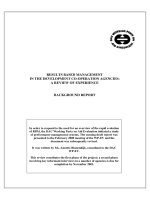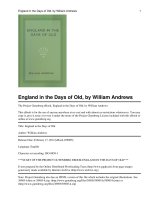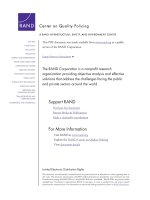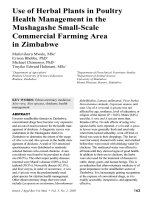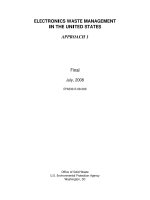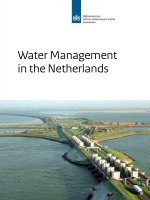LIFE Project Habitat Management in the Weidmoos Bird Reserve docx
Bạn đang xem bản rút gọn của tài liệu. Xem và tải ngay bản đầy đủ của tài liệu tại đây (4.72 MB, 32 trang )
ABirdParadise
Weidmoos
www.weidmoos.at
LIFE Project
Habitat Management in the
Weidmoos Bird Reserve
LIFE Project Weidmoos
A great success
There can be no better evidence of the success of the Weidmoos LIFE project than a walk through
the bog, with its revitalised variety of animals and plants. Over recent years a natural treasure –
and with it a valuable recreation area for the people of Salzburg – has been created from what
was an industrial wasteland, thanks to the combined forces of many helpers and volunteers.
Without the dedication of the local people, and especially the Association Torferneuerungsverein
Weidmoos, the Mountain Guards, the landowners and the representatives of the local communities
of Lamprechtshausen and St. Georgen, this project would not have been possible. The area, now full
of vegetation, is unrecognisable compared to its state before the beginning of the LIFE project.
It has been shown that even “second-hand Nature” can provide such incredible variety. That the
other plans for the area – landfill site, airport, industrial park – could have become a reality,now
seems unimaginable to us.
In our positions as member of the Regional Governmental responsible for environmental
protection, mayor,and Chair of the “Torferneuerungsverein Weidmoos”, we would like to thank
everybody who has contributed to the success of this project. In addition, the excellent
collaboration between those concerned on site and staff at Salzburg’s Nature Protection
Department, and in particular Bernhard Riehl, has led to an especial success.
Member of Regional Government
Sepp Eisl
Mayor Ing. Johann Grießner
Chair Torferneuerungsverein Weidmoos
Mayor Fritz Amerhauser
Vice-chair Torferneuerungsverein Weidmoos
WEIDMOOS A BIRD PARADISE 3
The Weidmoos
A bird paradise
made by Man
The Weidmoos was originally an extensive raised bog. For many decades,
peat was extracted here on an industrial level.When the last peat was
cut in 2000, Nature started to dominate the area once more.What came
to be created was a mosaic of ponds, reeds and willow bushes, providing
many rare species of bird with an ideal habitat.
The Weidmoos gradually became a bird habitat of European significance.
Over 150 species of bird have been identified so far, of which some are
endangered on a European level. One falling into this category is the
White-spotted Bluethroat, which is often to be seen at the Weidmoos,
whilst the Marsh Harrier preys over the extensive reeded areas, and
rare waders and waterfowl such as the Common Snipe and the Spotted
Crake rear their young here.Wood Sandpipers, Ruffs and other migrating
birds use the Weidmoos as an important stopover site. For this reason,
the Weidmoos was made part of the Europe-wide Natura 2000 network
of protected areas. In 2006 it was declared a nature reserve (Natur- und
Europaschutzgebiet), in accordance with the “Salzburger Naturschutz-
gesetz” (Nature Protection Law).
After the considerable interference caused by peat extraction, the Weid-
moos could not be simply left to its own. Otherwise the drained land
w
ould have sooner or later become a uniform wooded area. Therefore, a
LIFE project, entitled “Habitat Management in the Weidmoos Bird Reserve”
w
as undertaken between 2003 and 2007. The aim of this EUR
1.21m
project was to maintain the Weidmoos as a bird habitat through targeted
restoration measures, whilst at the same time rendering it more of an
experience for visitors.
Photos: R. Lindner, P. Buchner
4 WEIDMOOS A BIRD PARADISE
Formed
by glaciers
The landscape of the Weidmoos was formed by glaciers
during the Ice Age. In the dips scored by the moving
glaciers and behind the morainic walls, large lakes were
left behind as the glaciers melted. At the close of the
last Ice Age about 18,000 years ago, the retreat of the
large glaciers from the foothills of the Alps left behind
an extensive area of lakeland.
A landscape thousands of years old
The area covered by today’s Weidmoos was the site of
one such lake, at the bottom of which large deposits of
clay collected. This lake-clay continues to prevent rain-
water from seeping underground. After the River Salzach
had cut through the terminal moraine, the water level
fell and the lake became land over the course of time.
Peat mosses took over and gradually a peat-bog was
created. Over thousands of years, the peat mosses formed
an ever-thickening layer of peat. In this way, a continental
raised bog was created, with a 6-metre-thick layer
of peat. Right up until the 18
th
century, the peatland
between Ibmer Moor, the Weidmoos and the Bürmooser
Moor formed the largest connected system of bogs in
Austria, extending approximately 2000 hectares.
Cartography: H. Guggenberger
Photo: B. Riehl
The area between Weidmoos, Ibmer Moor and
Bürmoos must have looked much like this wide-
spread bogland in Latvia (Kemeri), before human
intervention altered the landscape forever.
Approximately 18,000 years ago, the ice-age Salzach glacier
stretched far into the northern foothills of the Alps. The retreat
of the glaciers at the end of the Ice Age left behind a wide-ranging
lakeland area. Many of these lakes dried up and formed bogs.
Alongside the area of peatland between Ibm and Bürmoos, a
range of other peatland areas developed in the Bavarian-
Salzburg Alpine foothills. On the map, the original peatland
areas are marked brown, though many of them have disappeared
through pea
t extraction and cultivation.The extent of the glaciers
during the last Ice Age is marked light blue.
WEIDMOOS A BIRD PARADISE 5
After over 150 years of peat extraction, there remains but a
fraction of the former raised bog. In these areas, one can still
find typical raised bog plants, such as various peat mosses
(sphagnum), sundew, bog-rosemary, cranberries and cotton-
grass. These remnants of the original Weidmoos can be seen
along the newly constructed themed footpath in the southern
part of the Weidmoos.
Photos: R. Hofrichter, A. Ausobsky, R. Lindner
6 WEIDMOOS A BIRD PARADISE
Up until well into the 18th century, the Weidmoos was,
like other large systems of boglands in the foothills of
the Alps, an almost inaccessible region feared by daunted
humans. Only a few dared undertake the route into
the bog.
In 1700, Archbishop J.E. Graf von Thun ordered for
“…
all bogs within the jurisdiction of the area before the
mountains to be described and reclaimed.”
It would take
almost a hundred years, however, before cultivation of
the bog commenced, in 1790.
Peat, provider of energy
The start of industrialisation and the increasing demand
for fuel which came with it caused widespread interest
in the combustible material known as peat. Peat was
of particular interest to the recently established glass
industry in Bürmoos. The raw materials for glass pro-
duction lay right at their doorstep: lime in Haunsberg,
sand from the River Salzach and peat from the bog.
As well as glass production, the manufacture of bricks
would also use peat as combustible fuel. After the collapse
of the glass industry, peat ceased to be extracted as
from 1930.
Even in those difficult times, peat retained its significance
and became an important source of income for many
people. Peat fields which had been mined were cultivated
and transformed into pastures and agricultural fields.
Peat extraction
at the Weidmoos
After the collapse of the glass industry in the 1930s, peat was
once again extracted for household use. In the years following
the Second World War in particular, many families leased peat
fields in order to extract combustible fuel. The peat extracted
covered not only that required for the family’s own use, but was
also sold, thereby providing the family with some income. The
traditional manual cutting of peat was almost completely
abandoned by the mid-1960s.
One of Salzburg’s
last remaining manual peat digs to be in
active use can be found in Weidmoos. It is now used for personal
use and traditional purposes. As it is located in an already very
dry and “overgrown” area of the Weidmoos, it does not constitute
a danger to sensitive habitats. In this picture you can see the
blocks of turf laid out for drying.
Widespread peat extraction transformed
the Weidmoos into an industrialised
landscape (Aerial shots of the extraction
sites from 1978).
The industrialisation of peat extraction
In 1947, the “Österreichische Stickstoffwerke AG Linz”, an
Austrian company based in Linz specialising in chemicals,
commenced the production of combustible peat and
peat dust on an industrial scale. The raised bog became
an industrial landscape. Until 1959, the peat was collected
using two large bucket dredgers, which were later
replaced by cutting extraction techniques. Today, only
a small fraction of the bog remains.
Photo: Archiv Torferneuerungsverein
Photo: A. Ausobsky
WEIDMOOS A BIRD PARADISE 7
In peat extraction by cutting, the peat was cut up into layers just a few centimetres
thick and turned over by the “riffler” until dry and harvestable.The peat was then
pushed into rows using an “agglomerator”. A narrow-gauge railway – the so-called
“Bockerlbahn” – was constructed to transport the peat to the converting plant in
Bürmoos.
From the mid-1950s onwards, peat was
extracted solely for the production of garden
potting soil.
Photos: Archiv Torferneuerungsverein
8 WEIDMOOS A BIRD PARADISE
A bird habitat, significant on
a European level emerged
Attempts to give the Weidmoos back to Nature have
been made since the 1980s. The thrust of plans of that
time were to have Nature, relaxation, hunting and exten-
sive cultivation working side by side. At the centre of the
former peat extraction area, a peatland stream was to be
created, and the existing ponds kept. With the exception
of some afforestation, these ideas did not get past the
planning stage.
Initial research into the Weidmoos bird population in
2000 and 2002 showed that some of Europe’s rarest
species of bird had found a place to fall back. There was
evidence of the presence of numerous breeding birds –
such as the Bluethroat, the Marsh Harrier, the Spotted
Crake and the Little Bittern – which benefit from the
highest level of protection on a European scale. The
Weidmoos was also found to be an important stopover
site for many migratory birds (ducks, wading birds, storks
etc.) on their way south. As a result of these discoveries,
the Weidmoos was incorporated into the Europe-wide
Natura 2000 network of protected areas (SPA).
From
industrial wasteland
to LIFE project
With 20 to 30 breeding pairs the Weidmoos is home to one of
Austria’s largest populations of the
White-spotted Bluethroat,
which is protected on a European level.
Photo: blickwinkel/M.Woike
After peat extraction ceased in 2000, only a small fraction
of the former raised bog remained. Most of the Weidmoos
had the appearance of an industrial wasteland.There
was great pressure to redevelop the fallow-lying site.
Suggestions for its future use ranged from the establish-
ment of a landfill site, to the building of an airport, to
the construction of a golf course and hotel.
Whilst people were discussing ideas as to the site’s futu-
re use, Nature re-conquered the Weidmoos. Reeds spread
along the length of the drainage channels and in the old
peat digs, whilst willows also took root. Over the years,
a multi-faceted mosaic of water, reeded areas, willows
and open areas of peat developed, and therewith a bird
habitat of a type rarely found today in a densely populated
central Europe.
WEIDMOOS A BIRD PARADISE 9
The traces of the peat extraction industry
are gradually being eroded with the encro-
achment of Nature.The Weidmoos has,
however, been permanently transformed
into a new landscape.
Natura 2000
Europe’s nature for you
The Weidmoos is part of the European Natura 2000 Network.
It has been designated because it hosts some of Europe’s
rarest bird species. All 27 countries of the EU are working
together through the Natura 2000 network to safeguard
Europe’s natural heritage for the benefit of all.
The basis of Natura 2000 are two EU environmental directives:
the so-called
“fauna-flora-habitat” directive (Council directive
92/43/EEC of 21
st
May 1992) and the bird protection directive
(Council directive 79/409/EEC of 2
nd
April 1979).
The European Championship stadium
helps the Weidmoos
An important step came in 2000, when nature protection
compensation measures were undertaken as a result
of the construction of a new stadium in Salzburg/ Kless-
heim. This involved the purchase of about 80 of the
136 hectare bird reserve for nature protection purposes.
In this way, the future use of the site was bound by
property law.
In 2002, Salzburg’s Nature Protection Department con-
tracted REVITAL, a civil engineering consultancy firm, to
develop a Natura 2000 management plan. The plan
addressed necessary measures pertaining to the develop-
ment of the Weidmoos within its nature protection remit.
The management plan was finalised with valued contribu-
tions from the populations of Lamprechtshausen and
St. Georgen and from landowners. It was at that stage
that the “Torferneuerungsverein Weidmoos” (Weidmoos
New Peat Association) was formed, whose objective is the
maintenance and improvement of the Weidmoos and
who has energetically supported the LIFE project.
Photo: Ch. Ragger/REVITAL
Photo: R. Hofrichter
10 WEIDMOOS A BIRD PARADISE
Today’s Weidmoos is not a natural habitat, but rather
a man-made one. The destruction of the raised bog
through peat extraction cannot be rolled back in a
foreseeable timeframe. Restoration measures cannot
therefore recreate the original raised bog. In fact the
“second-hand habitats” are to be maintained in the long
term as locations for breeding, feeding and resting for
birds. In order to achieve this however, the Weidmoos
cannot simply be left to its own.
Temporary bird paradise
The bird habitats which were formed after the end of
peat extraction would have only been a temporary
paradise. The large area of drained bog threatened to
become overgrown with bushes over the years, and
eventually to become a wooded area. The habitats
The Weidmoos
under threat of
becoming overgrown
which are so important to the birds, such as the reeds,
water bodies, individual bushes and open peatland would
have disappeared in the medium term – and with them
many species of bird.
In order to keep the Weidmoos for the birds for ever
more, a specific structuring and conservation of the
habitats (known as “habitat management”) was required.
The main task in this respect was the “re-waterlogging”
of the central area of the Weidmoos. For this to occur,
drainage ditches had to be closed off, and new ponds
created through the construction of dams. In the outer
areas, bush growth had to be prevented by mowing the
meadows once a year. All these measures ensure that
most of the Weidmoos remains open, and thereby
continues to attract waterfowl and birds which breed
in reeded areas and meadows.
2005
2025
WEIDMOOS A BIRD PARADISE 11
The drainage channels constructed in the course
of peat extraction had caused the Weidmoos to
dry out. This process had led to the threat of the
Weidmoos becoming wooded.
The Weidmoos in May 2005
Just a few years after the cessation of peat
extraction activities, Weidmoos had become
a mosaic of water, reeds and willow bushes –
a fascinating “second-hand” habitat and a
home for rare species of bird.
Scenario: The Weidmoos in 2025
without active habitat management
The extensively drained area has transfor-
med itself into a relatively uniform wood-
land. The majority of resident birds, who rely
on a landscape littered with water bodies
and moist areas, has disappeared.
Photo: A. Ausobsky
Illustration: E. Pratter
Photos: Ch. Ragger/REVITAL, Archiv Torferneuerungsverein
12 WEIDMOOS A BIRD PARADISE
The LIFE project
The funding for the required habitat management was
secured via the EU-supported LIFE project. Numerous
projects submitted entries – in Autumn 2002 – to the
Europe-wide competition for LIFE-programme funding.
The Weidmoos project was able to overcome this hurdle
despite strong international competition. This success
was an important foundation for the implementation of
the planned measures.
Project partners
The LIFE project was initiated and implemented by the
Salzburg Nature Protection Department along with the
Association Torferneuerungsverein Weidmoos and the
Lamprechtshausen and St. Georgen local councils.
Financing
The project budget for 2003 to 2007 was EUR 1.21m.
The project was funded by the European Commission
(50% “LIFE”), the Salzburg Regional Government – Nature
Protection (44%), the Federal Ministry for Agriculture,
Forestry, Environment and Water Management (3%),
the Lamprechtshausen and St. Georgen local councils
(1% each) and the Association Torferneuerungsverein
Weidmoos (1%).
The aim of the LIFE project entitled “Habitat
Management in the Weidmoos Bird Reserve”
was to maintain the Weidmoos as a significant
bird habitat for present and future generations
through active restoration measures, whilst at
the same time making it visitor-friendly.
From the beginning, the LIFE project was effected
with the close support of the populations
of Lampr
echtshausen and St. Georgen, the land-
owners and those authorised to use the land.
A range of informational presentations was
undertaken in the communities and on site
during the course of the project.
On 22
nd
July 2004, the official ground-breaking
ceremony took place at the Weidmoos. Sepp Eisl
(member of the regional government, responsible
for nature protection), inaugurated the
construction work.
Photos: Ch. Ragger/REVITAL (2), B. Riehl, F. Neumayr/LPB
WEIDMOOS A BIRD PARADISE 13
LIFE
LIFE is a promotional program of the EU to support nature
conservancy projects in Natura 2000 areas.
36 Austrian-based projects have been funded through
“LIFE Nature” since 1996, with a total project fund of over
EUR 101 m (as of March 2006). An overview of all these
projects can be found on the Life Ministry website:
/>The LIFE project entitled: “Habitat Management in the
Weidmoos Bird Reserve” was the second LIFE project in
Salzburg, the first being the “Wenger Moor” project. A third
such project received acceptance and was commenced in
2006, in the Natura 2000 area of Untersberg foreland
(Vorland) in the locality of Großgmain.
Information on other Salzburg LIFE projects:
Untersberg-foreland: www.untersberg-vorland.at
Wenger Moor: www.salzburg.gv.at/themen/nuw/natur-
schutz/naturprojekte/wengermoor.htm
Project’s aims for Nature …
The main aim of the LIFE project was the safeguarding
of the protected species of bird living at the Weidmoos.
To ensure the conservation of the Weidmoos as an area
for breeding, migration and overwintering, land was
purchased for nature protection purposes, and specific
flooding measures and the creation of new water
bodies were undertaken, as was the optimisation of
meadow use.
… and for Man
The LIFE project also committed itself to making the
Weidmoos visitor-friendly. A themed footpath, an infor-
mation centre and a viewing tower should make it possible
t
o experience the Weidmoos with minimal impact to
the birds.
Photo: Ch. Ragger/REVITAL
14 WEIDMOOS A BIRD PARADISE
Land acquisition
for the protection of Nature
The purchase of land or the lease of land use rights was
one of the important pre-requisites for the implementation
of the planned measures. Even prior to the start of the
LIFE project, 80 hectares within the Natura 2000 site
were purchased in 2000 within the scope of a prescribed
nature protection compensation measure. As part of
the LIFE project further 46 hectares were purchased (or
appropriate land use rights were obtained). The new
owners of the purchased land were the local councils,
whereby the use of the land for nature protection pur-
poses was ensured in terms of property law. Through
the close collaboration of the local councils and the
landowners, the implementation of the necessary water-
logging measures was ensured.
The purchase of land and land use rights was an essential
prerequisite for the implementation of the habitat restructuring
measures. 80 hectares had already been bought by the end
of 2000 (grey areas). A further 46 hectares were purchased
(or appropriate land use rights obtained) within the scope of
the LIFE project (light green areas). The red line indicates the
boundary of the Weidmoos Natura 2000 site.
Support from Landowners
More than 20 landowners sold their part of the Weidmoos –
or set it aside for nature protection – to the Lamprechtshausen
and St. Georgen local councils for the purpose of the conser-
vation of this unique habitat.
Many thanks go to: Josef Eder, Johann and Maria Kirnstedter,
Jana Kölblinger, Johannes Kölblinger and Julia Vogl-Fernheim-
Kölblinger, Katharina Lehmayer, Christoph Leitl, Cornelia Leitl,
Florian Leitl, Martin Leitl, Sabine Leitl, Franz Rieseneder,
Elisabeth Berger-Sandhofer, Dagmar Dabernig, Marlene
Dabernig, Heinrich Gassner, Georg and Beate Weilbuchner,
Stefan Reiter, Elisabeth Hauser, Frieda Kirnstedter, Franz and
Maria Schmidlechner, Dietmar Leopolder, Nicole Leopolder,
Michaela Leopolder, Herbert
Lindner, Rupert und Elisabeth
Wimmer, Günter Winter, Anita Renzl, Franz and Edith
Hochradl, Berta and Martin Hitzginger.
The commitment sho
wn by Anita Renzl should be highlighted
at this juncture. She donated the entire sum paid for her
land to the Association Torferneuerungsverein Weidmoos
for conservation purposes.
Photo: B. Riehl
Orthophoto (2002), Salzburger Landesregierung, FMM – Forest Mapping Management
Photo: K. Leininger
N
0 100 200 300 400 500 Meter
0 100 200 300 400 500 Meter
WEIDMOOS A BIRD PARADISE 15
16 WEIDMOOS A BIRD PARADISE
A total of 50 dams were erected at the Weidmoos. The plan
shows a cross-section through Dam no. 1, the largest of those
constructed. It dams the water for the pond in the southern
section of the Weidmoos, near the information centre. The over-
flow in this and other dams gives the desired water level and
ensures that, after heavy precipitation, surplus water can run off
without causing damage. Water from the Weidmoos eventually
runs into the Moosach.
Water for
the Weidmoos
In order to permanently preserve the quality of habitat
for bird species resident to the Weidmoos, it was essential
to alter the post-extraction state of the site, so that an
open landscape with numerous bodies of water and
moist areas would remain.
The most important measure to ensure the long-term
conservation of the Weidmoos as an open landscape –
and therefore as a valuable bird habitat – is the so-called
“re-waterlogging” of the site. Rainwater can be retained
in the area by closing drainage channels and through the
construction of dams, all of which will lead to the creation
of new ponds.
The Weidmoos itself had the ideal building material for
these dams: the clogging clay substrate (lacustrine clay)
could be retrieved and used on site.The remaining layer
of peat was removed and the dams poured in on top of
the clay substrate and thickened. Most of the dams are
relatively low-level (at 50cm – 1.5m) and therefore fitted
in so well to the surrounding land that just one or two
years after installation (when they have naturally vege-
tated) they cannot be seen against the original landscape.
Photos: Ch. Ragger/REVITAL
3D-Simulation:
REVITAL ecoconsult
Between 2003 and 2006, the Weidmoos was transformed
into a temporary “environmental building site”. Because
of the Weidmoos’ soft soil substrate, all the building work
required the use of special equipment which would not be
in danger of sinking into the bog. In-situ clay was used for
the construction of the dam structures, which was the first
time this method had been used in Europe.
The waterlogging measures were planned in detail and their
effect simulated with the aid of a 3D computer model based
on laser-scanned measurements.
Figure: taken from the detailed plan of
Engineers IGA Gostner & Aigner,Wals
In order to regulate water levels, overflow systems were
built in. This ensured that surplus water can, after heavy
precipitation, flow towards the Moosach to the north
of the Weidmoos, without damage being caused.
Small-scale landscaping of the banks of existing and
new water bodies created flat bank areas and water
transition zones.
WEIDMOOS A BIRD PARADISE 17
Waterlogging measures
As part of the LIFE project, 50 dam constructions were put up,
totalling approximately 2,500 metres in length. This corres-
ponded to a total volume of 21,000 m
3
of clay. 28 overflow
structures were integrated into the dam to regulate the
water level. In this way, more than 30 hectares of new water
bodies and moist areas were created.
In order to have as low an impact as possible on the Weid-
moos’ birds, the construction work was undertaken outside
of breeding time. Furthermore, the construction works
were split over two years so as to ensure that at least a
part of the Weidmoos would remain unaffected during the
construction works.
The red lines on this plan show the location of the construc-
ted dams. The newly created water bodies are marked blue.
Yellow line: boundary of the Natura 2000 site. Detailed
plans like this were the basis for the legal permission of the
measures by the Salzburg Water and Forest Authority.
Photo: B. Riehl
Orthophoto (2002): Land Salzburg, FMM – Forest Mapping Management,
3D-Modelierung: REVITAL Ziviltechniker GmbH
0 100 200 300 400 500 Meter
0 100 200 300 400 500 Meter
N
18 WEIDMOOS A BIRD PARADISE
During every year that the LIFE project ran, a meeting was
held with the farm managers with the aim of discussing
and optimising these measures as regards the meadows.
Maintenance of vegetation-free areas
Once a year, and in selected zones, vegetation-free areas
are created using the “bog crawler-mobile’s” levelling
plate or using a cutter. In this way, vegetation-free and
low-vegetation areas – so important for the Bluethroat –
will remain in the long term.
Tending of trees etc.
So as to prevent the newly created water bodies and the
meadows becoming overgrown with trees and bushes,
specific trees etc. must be removed on a regular basis.
Only in this way can the open character of the Weidmoos
be kept. The aim is not to completely remove all types
of tree and bush, but rather the long-term conservation
of a multi-faceted mosaic of various habitats.
Recurring
maintenance
In order to maintain the quality of the Weidmoos bird
habitat, regular recurring maintenance measures have
to be undertaken, in addition to the re-waterlogging.
The following measures were, and will continue to be
regularly undertaken:
Mowing of the meadows and the
reeded areas
Regular mowing is necessary in order to prevent the mea-
dows and reeded areas becoming overgrown with trees
etc. This mowing is specially adapted to the needs of the
bird species found here. Farmers from the surrounding
land mow the meadows between July 15
th
and the end of
September every year. A total of approximately 30 hectares
of meadow are now regularly used on the Weidmoos.
The maintenance measures for the meadows were
– within the scope of the LIFE project – planned
in detail and finalised over the course of the years.
For example, different meadow areas get mown at
different dates. The basis for the maintenance work
was, in all cases, the maintenance objectives laid
out in the management plan. The earliest mowing
dates are shown on the map with different colours:
violet – 15
th
July; green – 1
st
August; orange – 15
th
August; red – 1
st
September.
Map: REVITAL Ziviltechniker GmbH
(part of the meadow management plan)
WEIDMOOS A BIRD PARADISE 19
Many people help to
maintain the Weidmoos
The necessary maintenance measures are only possible
with the energetic assistance of numerous people and
organisations: Peter and Veronika Armstorfer, Vinzenz and
Frieda Hochradl, Josef and Martina Hangöbl, Martin Gradl,
Klaus and Barbara Ferster
er, Franz Hochradl, Monika and
Gottfried Rehrl, Elisabeth and Johann Spitzauer and Markus
Költringer-Winter all mow the meadows in accordance with
the given guidelines with admirable application. The local
hunting group supports the Association Torferneuerungs-
verein Weidmoos with diverse tree-cutting measures.
Regular mowing is a decisive factor in preventing the Weidmoos
from becoming overgrown with bushes. Pictured: Jakob Hofbauer,
one of the indefatigable volunteers involved in the execution of
maintenance measures.
The regular ripping-up of the ground creates the vegetation-
free surfaces which are so important for some species of bird.
In the foreground: the “bog crawler”, a piece of equipment pre-
viously deployed for peat extraction. LIFE funding enabled the
crawler to be adapted for nature protection purposes. In the
background one can see the recently turned areas, now free
of vegetation.
Photo: M.Weiß
Photo: R. Kaiser
20 WEIDMOOS A BIRD PARADISE
After the conservation of bird habitats, the second aim
of the LIFE project was to make the Weidmoos visitor-
friendly. To this end, it was made possible – in the
southern part of the Weidmoos – to visit the area
without disturbing the bird habitats. In the meantime
the Weidmoos has become a well known attraction for
nature loving visitors.
Nature Experience
at the Weidmoos
A new themed footpath invites you to learn about a unique
bird world and about the variety of bird habitats. The visitor is
informed as to the creation and ecology of the Weidmoos over
the 1.5km path, as well as the history of peat extraction and
the bird species which are characteristic of the Weidmoos. The
highlights of the themed footpath are the “bird observation
hides”, the bog platform and the peat cutting site.
The information centre houses an exhibition, presenting a
variety of information concerning the Weidmoos and the
LIFE project. (Opening times and further information at
www.weidmoos.at). It is also the focal point for all related
events and activities (such as the grand opening, pictured).
Photos: R. Lindner, R. Nestelbacher
Photos: R. Nestelbacher
WEIDMOOS A BIRD PARADISE 21
A 12-metre-high viewing tower offers impressive views over
the Weidmoos and also excellent bird-spotting opportunities.
With the appropriate equipment (field glasses, spotting scope)
it is possible to observe both popular bird species and, with a
bit of patience, rarities such as the Little Bittern or various
wading birds.
As part of the LIFE project, a former peat-workers’ hut was
converted into an information centre.
Obertrum
Michaelbeuern
Berndorf
Laufen
Salzburg
Mattsee
Obertrumer See
Ibmer See
Salzach
Vienna >
< Munich
D
A
Weidmoos
Oberndorf
St. Georgen
Ibm
St. Pantaleon
Lamprechts-
hausen
Freilassing
Visit the Weidmoos!
The Weidmoos is located approx. 20km north of the city of
Salzburg. It is well signposted from both Lamprechtshausen
and St. Georgen.
For detailed directions, information centre opening times and
further information regarding the Weidmoos and the LIFE
pr
oject can be found at www.weidmoos.at.
Two information folders, two posters and one film (on DVD)
were also produced as part of the project. The DVD (EUR 7.90),
folders and posters can be obtained via the Association
Weidmoos Torferneuerungsverein Weidmoos or the Nature
Protection Department (Contact refer to page 29).
Photo: Gemeinde Lamprechtshausen
Photos: Ch. Ragger/REVITAL
22 WEIDMOOS A BIRD PARADISE
The aim of the LIFE project was the long-term conser-
vation of the Weidmoos as a breeding, migration and
overwintering site for a range of bird species which had
become rare on a European level. As the project-related
monitoring has demonstrated, this objective was met
100% successfully. The waterlogging measures ensured
that exactly those water and moist habitats were created
which are necessary for the conservation of these species.
The ornithological surveys demonstrated that the new
habitats were adopted by many endangered species of
bird. In this manner, it was not only possible to secure
the habitat of the species specified in the LIFE project:
habitats for many incoming species were also created.
Almost every year species which are new to the area can
be observed. Particularly noteworthy was the presence
of Little Bitterns and Great Bitterns during the breeding
season in 2005 and 2007! The Bluethroat population
seems to have decreased somewhat, but is still conside-
rable. Two pairs of March Harriers were breeding at the
Weidmoos through the entire duration of the project.
Visible results!
In November 2006, nature protection experts visited the
Weidmoos as part of a LIFE conference. The Weidmoos had been
chosen as a best practice example for restoration projects.
Representatives from the EU and from the Federal Ministry
for Agriculture, Forestry, Environment and Water Management
came to the Weidmoos once a year in order to get an impres-
sion of the project’s progress.
The Weidmoos also gained in significance for many other
bird species, thanks to the LIFE project. For example,
many types of duck now breed at the Weidmoos. Species
such as the Little Grebe and the Water Rail are now typical
of the Weidmoos. Even rare reed-dwellers, such as the
Great Reed Warbler found a new habitat at the Weidmoos.
The essential basis of this success story is the close
collaboration and trust shown by the Nature Protection
Department, the Association Torferneuerungsverein, the
local councils, landowners, farmers and hunters. A big
thank you goes to all those who have worked to make
the project such a success. This successful co-operation
within the LIFE project has demonstrably contributed to
the Weidmoos being accepted as a nature reserve and
to the idea behind “Natura 2000” in general. The swarm
of visitors who turn up to excursions and other events at
the Weidmoos demonstrates this.
Areal view of the Weidmoos Natura
2000 site taken in June 2005
Photo: Ch. Ragger/REVITAL
Photo: K. Michor/REVITAL
Photo: K. Leininger
WEIDMOOS A BIRD PARADISE 23
Aerial view of the Weidmoos shortly after the cessation of
peat extraction in 2000.
The Weidmoos is changing
Thanks to the successful restoration measures, what was
an industrial wasteland has been transformed into a diverse
habitat with water, reeded areas and a rich patchwork of
plants.
The re-waterlogging and the recurring maintenance
work ensure that this important habitat for rare birds
will remain in the long term. In order to achieve this, the
f
ollowing has been undertaken:
• 46 hectares were purchased or leased as a pre-requisite
f
or later measures,
• 50 dams, with a combined length of around 2.5km were
built,
which required 21,000m
3
of cla
y,
• more than 30 hectares of ponds and moist areas were
newly created,
• 30 hectares of meadow were established and mowing
methods optimised
Photo: Torferneuerungsverein Bürmoos
24 WEIDMOOS A BIRD PARADISE
Birds at the Weidmoos
significant on a
European scale
Two pairs of Marsh Harriers (1) regularly breed at the Weidmoos.
They build their nests in the extensive reeded areas of the central
part of the Weidmoos.
Water Rails (2) are very secretive relatives of the more well-
known Coot. They breed in the reed thickets of the Weidmoos.
Wood Sandpipers (3) are birds which breed on northern
European boglands. They are regularly seen at the Weidmoos
on their way to and from their overwintering sites.
The Great Bittern (4) and the Little Bittern (12) are two species
of bird which are particularly endangered and therefore pro-
tected on a European level. Both species have been observed
breeding at the Weidmoos on a number of occasions.
Curlews (5) use the meadows as breeding grounds and raise
their young here.
Little Ringed Plovers (6) breed on the vegetation-free edges of
the banks. Two pairs have been observed at the Weidmoos.
Redshanks (7) were native to the Wallersee Lake until well into
the 1960s. In 1966, this breeding event finished, which makes
the spotting in June 2007 of Redshanks in the Weidmoos even
more significant.
The meadows of the Weidmoos are the breeding grounds of
several pairs of
Snipes (8). They have become very rare in our
heavily used landscape.
Several pairs of
Garganey (9) breed at the Weidmoos ponds.
Great Egrets (10) were rare guests to the Salzburg area up until
just a few years ago.The only other place in Austria where they
breed is at the Neusiedlersee Lake. Now up to 20 Great Egrets are
often seen at the Weidmoos over the winter months.
Grey Shrikes (11) were previously widespread, but were forced
out of many regions because of changing land use. Grey Shrikes
are partial migrants, which means that only birds from northern
breeding grounds fly south in the winter, whilst others overwinter
at their breeding grounds. A number of individuals regularly
spend the winter at the Weidmoos.
The ornithologist Norbert Pühringer (pictured, left), Martin
Brader and Christian Ragger (pictured, right, with his son
David) have documented the changes to the bird popu-
lations annually.
The Weidmoos is a bird habitat of European significance.
The diverse mosaic of water bodies, muddy areas and
reeds provides many species of bird with ideal conditions
for breeding and resting. Comparable habitats have all
but disappeared in our densely populated and heavily
utilised landscape.
Over 150 species of bird have so far been confirmed,
some of which are endangered on a European level.
One of the latter group is the White-spotted Bluethroat,
which can frequently be found at the Weidmoos. Marsh
Harriers prey over the extensive reeded areas, whilst rare
wading birds and waterfowl such as the Common Snipe
and the Spotted Crake raise their young here. The Weid-
moos is an important stopover site for Wood Sandpipers,
Ruffs and other migratory birds. Winter sees the arrival
of, amongst others, the Grey Shrike, the Hen Harrier and
the Great Egret. The effects of the restoration process on
the birds were documented using detailed monitoring
techniques. The Weidmoos has become one of the best
documented bird habitats in Salzburg.
Photo: R. Nestelbacher
Photos: blickwinkel/M. Hoefer (1), A. Ausobsky (5),
S. Rieser (6), G. Rossen (7), P. Buchner (2, 3, 4, 8, 9, 10, 11, 12)
WEIDMOOS A BIRD PARADISE 25
1
2 3
5
7
8
9 1210
6
4
11

